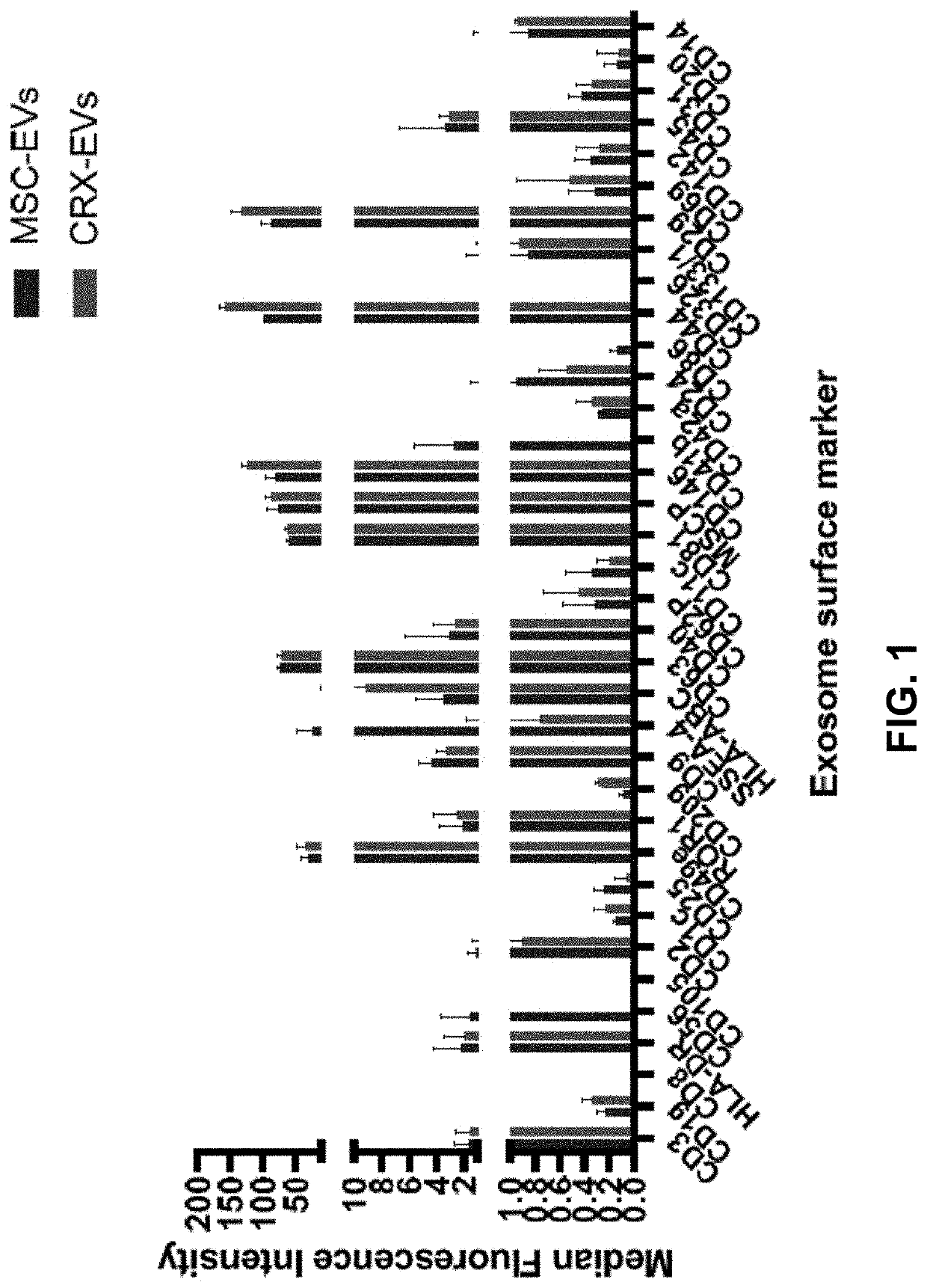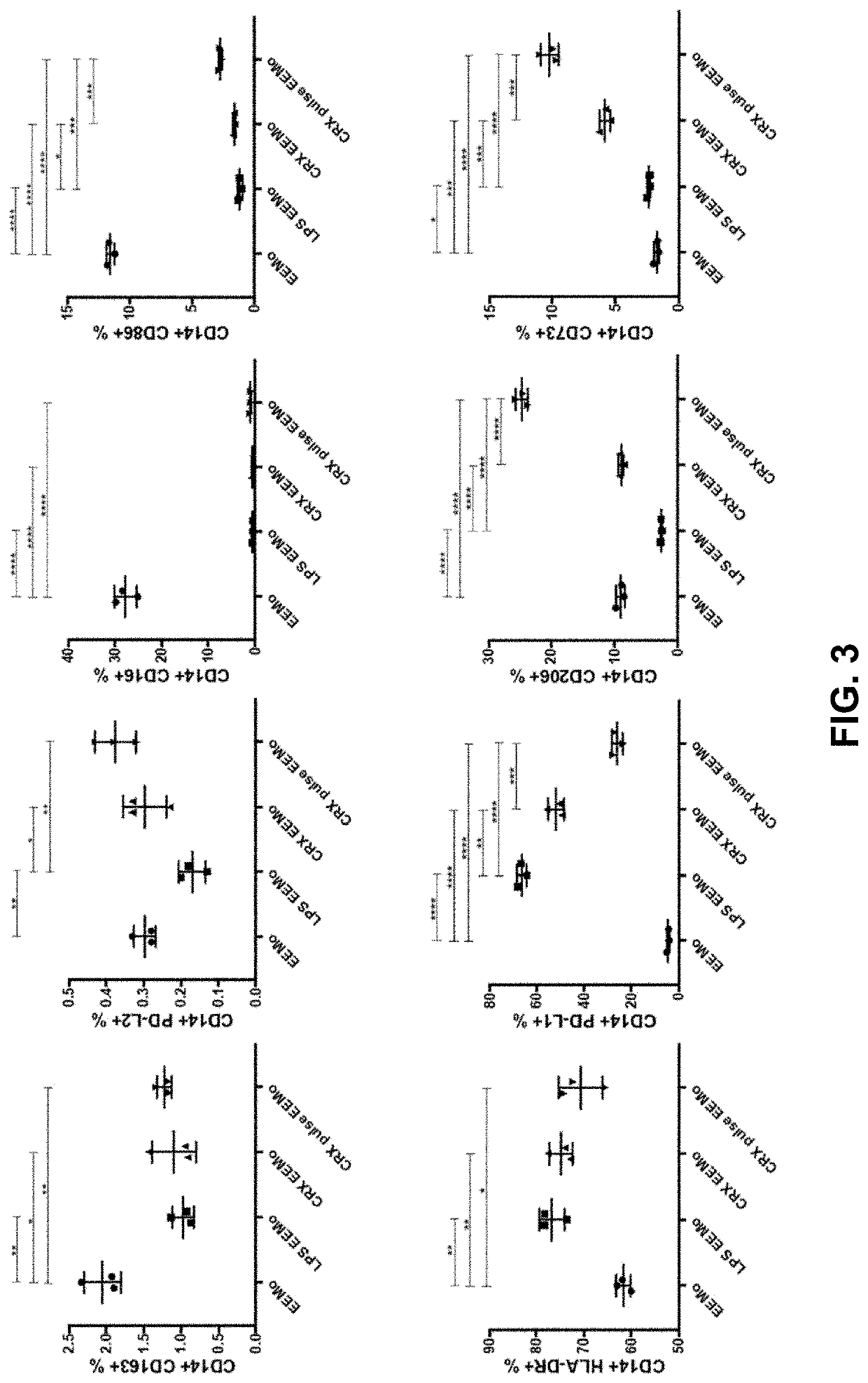Use of Toll-Like Receptor 4 Agonists to Treat Inflammation and Tissue Injury
a toll-like receptor and agonist technology, applied in the field of toll-like receptor 4 agonists to treat inflammation and tissue injury, can solve the problems of inability to identify the entire bmt process, inflammation and damage of highly proliferative cells, and the ars with life-threatening toxicities, etc., to achieve effective treatment, increase cell types, and improve the effect of treatmen
- Summary
- Abstract
- Description
- Claims
- Application Information
AI Technical Summary
Benefits of technology
Problems solved by technology
Method used
Image
Examples
example 1
ng MSCs with TLR4 Agonists to Produce Therapeutic EVs
[0152]Anti-inflammatory, regenerative cells were produced by stimulating secretion from MSCs of EVs using a synthetic TLR4 agonist. EVs were heterogeneous in size and included small exosomes (50-200 nm) and large microvesicles (400-1000 nm). Described herein is an ex vivo process, where the type of EVs produced by MSCs was directly controlled by stimulating them with a TLR4 agonist. TLR4 agonists such as bacterial lipopolysaccharides (LPS) are typically considered pro-inflammatory, and direct stimulation with LPS usually signals cells to produce cytokines that potentiate more inflammation. Stimulating MSCs with TLR4 agonists promoted an opposite effect, due to the immunomodulatory nature of MSCs. The synthetic TLR4 agonist CRX-527 was used, instead of natural sources of LPS derived from gram negative bacteria because CRX-527 is much less toxic than LPS to humans and possesses superior purity without contaminants.
[0153]MSCs were st...
example 2
Cells Ex Vivo with CRX-EV
[0154]Monocytes were exposed ex vivo to CRX-EV to produce CRX-EEMos. Monocytes were separately exposed to MSC-exosomes to produce control EEMos. CRX-EV polarized monocytes into a unique M2-like phenotype, compared to the EEMos. Gene expression for IL-6, IDO, FGF2, IL-10, IL-12, IL-7, IL-8, IL1B, VEGFA, NF-KB, and IL-23 was significantly higher (P≤0.05) in the CRX-EEMos compared to the control monocytes (Table 1). A subset of these genes—IL-6, IL-10, IDO, IL-8, IL-1B, VEGFA and IL-23—was higher in the CRX-EEMos than in the EEMos. (P≤0.05). Overall, gene expression was mostly higher in the CRX-EEMos than in the CRX-pulse-EEMos, but statistically so only for IL-1B. Of note, gene expression of pro-inflammatory cytokine IL-12 was two-fold lower for CRX-EEMos than for the CRX-pulse-EEMos.
[0155]Statistical significance of mean levels of gene expression by qPCR of monocytes educated with MSC-EVs (EEMos), monocytes educated with 2 hour pulse CRX-EVs (CRX-pulse EEMos)...
example 3
Cells Ex Vivo with CRX-EV in an Immunocompromised ARS Mouse Model
[0161]Four hours after a 4 Gy lethal radiation dose, a single dose of 1×107 educated monocytes was administered i.v. in a xenogeneic ARS mouse model. CRX-EEMos were significantly more effective than EEMos or PBS in protecting these mice from the lethal effects of ARS (FIG. 4A). The health of the mice, assessed by clinical scores and % weight loss, was also significantly improved in mice treated with CRX-EEMos (FIG. 4B). In contrast, CRX-pulse-EEMos did not effectively protect the mice from ARS (FIG. 4C). Recovery from ARS was assessed by monitoring CBC in mice before and at 5 days and 29 days after radiation exposure. While the CBC in the test groups declined at day 5, the white blood cell count (WBC) of neutrophils, lymphocytes, and monocytes improved to pre-radiation levels at day 29 in the mice treated with CRX-EEMos. This recovery was not evident in the surviving EEMos-treated mouse (Table 4).
TABLE 4CRX-EEMos helpe...
PUM
| Property | Measurement | Unit |
|---|---|---|
| diameter | aaaaa | aaaaa |
| diameter | aaaaa | aaaaa |
| diameter | aaaaa | aaaaa |
Abstract
Description
Claims
Application Information
 Login to View More
Login to View More - R&D
- Intellectual Property
- Life Sciences
- Materials
- Tech Scout
- Unparalleled Data Quality
- Higher Quality Content
- 60% Fewer Hallucinations
Browse by: Latest US Patents, China's latest patents, Technical Efficacy Thesaurus, Application Domain, Technology Topic, Popular Technical Reports.
© 2025 PatSnap. All rights reserved.Legal|Privacy policy|Modern Slavery Act Transparency Statement|Sitemap|About US| Contact US: help@patsnap.com



